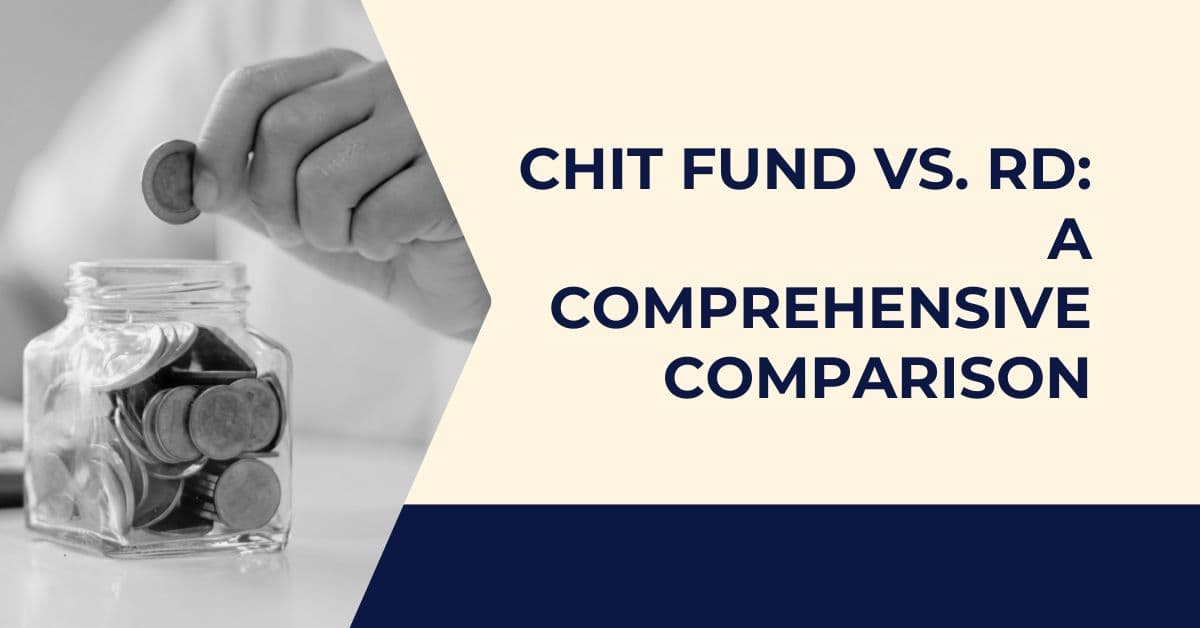RD vs Chit Fund: Millions of Indians prioritise setting monthly financial goals, such as saving for a ₹1 lakh emergency fund, a ₹2 lakh wedding, or a ₹50,000 phone. According to economic assessments, there will be over 400 million middle-class savers by 2025, and with inflation at 5–6%, choosing the appropriate investment instrument is essential to keeping ahead. Recurring Deposits (RDs), a bank-backed savings plan, and Chit Funds, a conventional peer-to-peer system, are two well-liked choices. However, which one best fits your monthly objectives? Should you join a ₹1 lakh chit fund in Chennai or deposit ₹5,000 a month in an RD with SBI in Delhi?
We will discuss returns, dangers, accessibility, and more for specific cases, such as a paid worker in Mumbai saving ₹10,000 monthly or a housewife in Kolkata pooling ₹2,000. Managing money is now simpler than ever thanks to India’s booming digital economy, which had 14.4 billion UPI transactions in February 2025. Starting today, let’s examine how RDs and chit funds work together to help you achieve your monthly objectives!
Why monthly goals are important in India
Due to economic realities and cultural norms, saving consistently is a fundamental aspect of Indian households. A monthly salary of ₹30,000 must pay for groceries (₹5,000), rent (₹10,000), and other expenses like a family trip or a child’s schooling. While unforeseen expenses (such as a ₹20,000 medical expenditure) necessitate a cushion, inflation erodes savings—₹10,000 in 2020 buys ₹7,500 in 2025. Chit funds and RDs are well-liked because:

- Discipline: A habit is formed with ₹2,000 in fixed monthly donations.
- Accessibility: Begin with ₹1,000 (chit fund) or ₹500 (RD).
- Objective: ₹5 lakh in 5 years for a car, or ₹50,000 in 2 years for a gadget.
- Flexibility: Chit funds provide loan-like access, and RDs are secure.
- Trust: regulated companies for chits, banks (SBI, HDFC) for RDs.
However, each has trade-offs: chit funds are dynamic but hazardous, whereas RDs are safe but small. Let’s dissect it to see which option best suits your monthly objectives.
Chit Fund vs. RD: A Comprehensive Comparison
With insights for savers like you, let’s analyse important criteria like returns, risks, accessibility, and more to determine which is ideal for your objectives in India.

1. What Are Chit Funds and RDs?
RD, or recurring deposit:
- Bank/post office plan: deposit a certain sum each month (for example, ₹5,000) for a predetermined period of time.
- Providers include ICICI, SBI, HDFC, and the Post Office.
- Use: Savings for emergencies, travel, and education.
- For instance, ₹5,000 each month for five years at 6% is equal to ₹3.5 lakh.
Chit Fund:
- Members of the group savings plan pool their monthly contributions (for example, ₹5,000) and bid or draw lots to receive a lump sum payment.
- Providers include local organisers and regulated companies like Margadarsi and Shriram Chits.
- Use: Savings with loan-like access for debt relief, weddings, and businesses.
- For instance, ₹5,000 every month for 20 months equals ₹1 lakh pot; bid ₹80,000.
2. Returns
RD:
- Fixed: 5–7% annually (Post Office 6.7% in 2025, SBI 6.5%).
- 6% for five years at a rate of ₹5,000 per month is guaranteed to be ₹3,48,300 (plus interest of ₹48,300).
- What Makes Stable? quarterly compounds with bank backing.
- Tricks: For greater rates (6.5% vs. 5.5%), select longer tenures (5 years vs. 1).
Chit Fund:
- Variable: Depending on bidding, effective returns range from 4 to 12%.
- You can bid ₹80,000 (4% return) or save the entire ₹1 lakh (10% loss if you bid early). Not guaranteed: ₹5,000 every month for 20 months equals ₹1 lakh pot.
- Why is it variable? The time of the auction affects returns; late bidders receive higher payouts.
- Tips: For larger profits (8–12%), bid late (months 15-20).
Goals Winner: RD—reliable results fit set goals (₹1 lakh in two years).
3. Risk
RD:
- Low: SBI and HDFC secure, government-insured up to ₹5 lakh (DICGC).
- Risk: Longer-term interest rate lockdown (6.5% to 6%).
- For instance, Priya’s ₹10,000 monthly RD increased to ₹7.5 lakh in only five years with no loss.
Chit Fund:
- High: Regulated chits (RBI, Chit Funds Act) are safer but may have defaults; unregulated chits are more susceptible to fraud.
- Risk: If a member leaves, the pot will reduce by ₹1 lakh; if the organiser fails, ₹50,000 will be forfeited.
- Example: Shriram Chits paid in full when Anil lost ₹20,000 in a local chit.
RD—zero loss for risk-averse savers—won the Goals competition.
4. Availability
RD:
- Simple: Open at banks or post offices (minimum of ₹500) or online (SBI, Groww).
- Documents: 5-minute setup for Aadhaar, PAN, and KYC.
- Why Is It Easy? Digital channels: ₹1,000 RD using UPI.
- For instance, Sunita used the HDFC app to open ₹2,000 RD with auto-debit enabled.
Chit Fund:
- Moderate: Local chits require trust; join registered businesses (minimum of ₹1,000).
- Documents: Aadhaar, PAN, proof of address—delays of 1-2 days for group verification.
- What Makes It Tough? Few businesses—Shriram in major cities, sparse in Tier-2 cities.
- Example: After three days of verification, Ravi joined a ₹5,000 chit.
Goals Winner: RD—wider, quicker access to monthly plans.
5. Duration
RD:
- Six months to ten years is flexible; choose from one year (₹12,000) or five years (₹3.5 lakh).
- Why Is It Good? Long for mansions (₹5 lakh), short for gadgets (₹50,000).
- Hacks: Lose ₹10,000 compared to the target of ₹50,000 if you break RD early (1% penalty).
- For instance, Anil’s two-year bike purchase is ₹5,000 RD, or ₹1.3 lakh.
Chit Fund:
- Fixed: ₹1 lakh pot for 12–50 months—₹5,000 for 20 months.
- Why Is It Rigid? Group contract: Contributions are lost (₹10,000).
- Tips: Select shorter (12-month) chits for ₹12,000 pot, which reduces risk.
- For instance, in month ten, Priya’s 20-month ₹5,000 chit yielded ₹80,000.
Winner for objectives: RD—various objectives are matched with variable tenures.
6. The state of liquidity
RD:
- Moderate: Loss of ₹10,000 on ₹1 lakh for an early withdrawal with penalty (5.5% vs. 6%).
- Loan Option: ₹90,000 loan on ₹1 lakh, 90% of RD value @ 7-8%.
- For instance, Sunita borrowed ₹50,000 with no repayment against ₹60,000 RD.
Chit Fund:
- Low: Bid for a lump amount of ₹80,000 in month five and return ₹1 lakh.
- No Exit: Quit in the middle of a chit and forfeit ₹20,000 in donations.
- For instance, Ravi paid ₹20,000 over 15 months after placing an early offer of ₹80,000.
RD—easier access for emergencies—won the Goals award.
7. Taxes
RD:
- Interest (₹10,000 at 20% = ₹2,000 tax) is taxable.
- TDS: 10% (₹1,000 TDS on ₹10,000) if interest exceeds ₹40,000 annually.
- Tricks: Avoid TDS and split RDs (₹5 lakh vs. ₹10 lakh).
- For instance, Anil’s interest of ₹12,000 is equal to ₹2,400 in tax (20% slab).
Chit Fund:
- Complex: Dividends fluctuate; interest is taxed (₹5,000 at 20% equals ₹1,000).
- No TDS: If you bid early, a lump payment of ₹80,000 will be taxed as income.
- Hacks: Postponed bid— ₹80,000 less taxable than ₹95,000.
- For instance, Priya’s ₹1,000 tax is equal to her ₹5,000 chit dividend.
Goals winner: RD—beginners’ easier tax.
8. Adequacy of the Goal
RD:
- Best: Set objectives: ₹2 lakh for schooling and ₹50,000 for a phone.
- Why? ₹5,000 a month at 6% is assured to be ₹1.3 lakh in two years.
- For instance, Sunita’s ₹3,000 RD will be worth ₹1 lakh in fees over three years.
Chit Fund:
- Best: One lakh rupees for the wedding, fifty thousand rupees for the business.
- Why? In month ten, bid ₹80,000 and return ₹5,000 per month.
- For instance, Anil’s ₹5,000 chit is worth ₹80,000 for a store.
Goals Winner: Depends—chit for early access, RD for assurance.
Which is better for monthly goals in India?
| A factor | Repeated Deposit | Chit Fund | Ideal for Objectives |
| Returns | 5-7% fixed | 4-12% fluctuation | RD |
| Risk | Bank-insured, low | High risk of default | RD |
| Accessibility | Simple—₹500, online | Moderate—1,000 naira, screening | RD |
| Duration | 6 months to 10 years | 12 to 50 months | RD |
| Liquidity | Moderate—penalty, loan | Low—lose or bid | RD |
| Taxes | Simple and taxable | Taxable and intricate | RD |
| Goal Adequacy | Savings that are fixed | One-time requirements | Tie |
When to Select an RD

Ideal For: Consistent savings (between ₹50,000 and ₹5 lakh).
Situations:
- For a phone, save ₹1 lakh over two years, or ₹4,000 per month at 6%.
- In five years, build ₹3 lakh for education, or ₹5,000 every month.
- Emergency fund: ₹2,000 every month for two years equals ₹50,000.
Why: Online access, 6% savings over 3%, and safety (₹5 lakh insured).
Risk: Poor returns (6% compared to 12% for equities).
The Best Time to Select a Chit Fund
Ideal For: Early access to a lump sum payment (₹50,000–₹2 lakh).
Situations:
- A wedding will cost ₹80,000 in ten months, or ₹5,000 each month.
- With ₹1 lakh, open a store; bid first, pay later.
- Flexible bidding, irregular income of ₹2,000 per month.
The reason is that loan-like products yield 8–12% returns for late bidders.
Fraud risk: stay with Margadarsi and Shriram.
Conclusion for Monthly Objectives
- RD Wins: For stress-free, safe goals—₹1 lakh in two years. Perfect for risk-averse savers, salaried individuals, or students.
- Chit Fund Wins: For large, urgent payments, ₹80,000 over 12 months with flexible payback terms. Ideal for business owners or anyone in need of quick cash.
- Advice: Combine the two: ₹2,000 chit for liquidity and ₹3,000 RD for safety.
Examples from Real Life
The Bike Fund of Anil
Hyderabad-based Anil, 25, makes ₹30,000 a month:
- RD: ₹1.3 lakh, or ₹5,000 per month at 6% for two years.
- Used: Purchased a bike at 1.2 lakh rupees.
- He says, “Safe and steady.”
The Wedding Plan of Priya
Priya, a 30-year-old Chennai resident earning ₹40,000 a month:
- ₹10,000 every month for 20 months, with a bid of ₹1.8 lakh in month 12.
- Funded wedding décor was used.
- “I had money when I needed it,” she says.
Sunita’s Educational Objective
Sunita, a housewife from Kolkata who is 35 years old and makes ₹5,000 a month:
- RD: ₹80,000 (₹2,000 per month at 6.5% for three years).
- Used: Son’s fees were paid.
- “Don’t worry,” she says.
Smart Tips for Indian Savers
- Compare rates: Use BankBazaar to compare rates; SBI RD at 6.5% against HDFC 6% saves ₹5,000 year.
- Verify Chits: Check the RBI, Chit Funds Act—Shriram vs. local avoids 20,000 loss to confirm the chits.
- Emergency Fund: ₹10,000 in savings, which includes chit bids and RD fines.
- Digital Tools: PhonePe (tracking) and Groww (RD)—five minutes to set up.
- Tax Plan: Split RD (₹5 lakh)—tax reduced by ₹2,000 as opposed to ₹10 lakh.
- Start Small: ₹1,000 in two years, or ₹500 RD.
- Learn: RD, chit fundamentals on YouTube (e.g., Labour Law Advisor).
Typical Problems and Solutions
- Problem: Low RD returns (6%), which is a challenge.
Solution: In five years, add ₹500 SIP (12%) to ₹1 lakh. - Problem: Fears of chit fraud.
Solution: Join Margadarsi to avoid local loss and save ₹1 lakh. - Problem: The problem is that RD payments are missing.
Solution: ₹5,000/month auto-debit with no skips. - Problem: Confusion in chit bidding is the challenge.
Solution: ₹95,000 vs. ₹80,000 for the late bid (month 15). - Problem: Uncertainty about the goal is a challenge.
Solution: The answer is to cover both RD for ₹50,000 and chit for ₹80,000.
Why This Decision Is Important in India
India’s savings culture thrives on discipline, as evidenced by its ₹50 lakh crore in deposits by 2025:
- Trust: 70 million savers having RDs with SBI and chits with Shriram.
- Digital edge: 5-minute RD setup for apps and UPI.
- Economic Need: ₹5,000 saved = ₹5,000 earned, assuming a 5-6% inflation rate.
Resources and Tools
- Apps: ClearTax (tax), Groww (RD), and PhonePe (payments).
- Websites: Moneycontrol (advice) and RBI (chit regulations).
- Freebies: include YouTube videos and RD calculators (SBI).
- Communities: For advise on saving money, see r/IndiaInvestments.
Choose Your Path Today
Start achieving your monthly objectives right away:
- Before April 20, 2025, open ₹500 RD.
- By April 30, 2025, join the ₹1,000 chit or confirm RD.
- By May 10, 2026, save ₹50,000.
Your dreams might be powered by a chit fund or an RD. To encourage wise saving, share this information with your loved ones. Every Indian may reach their monthly objectives if they make the correct decision!
Monthly Budgeting Made Easy for Indian Families
Smart Ways to Budget Salary with EMIs Every Month
Smart Budgeting for Women: Take Control of Your Finances

